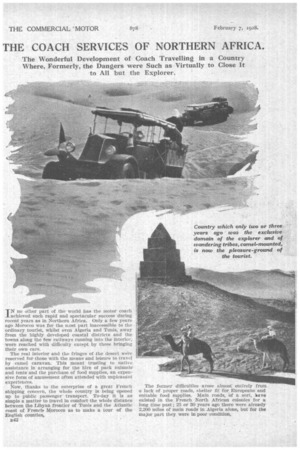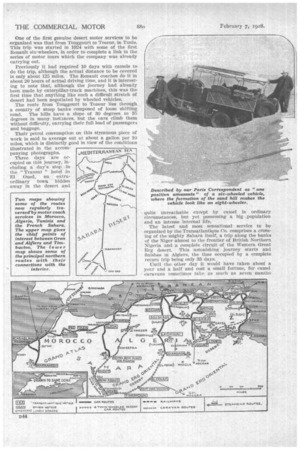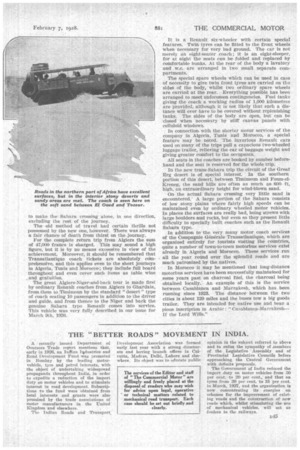THE COACH SERVICES OF NORTHERN AFRICA.
Page 116

Page 117

Page 118

Page 119

If you've noticed an error in this article please click here to report it so we can fix it.
The Wonderful Development of Coach Travelling in a Country Where, Formerly, the Dangers were Such as Virtually to Close It to All but the Explorer.
IN no oilier pan of the world has the motor coach achieved such rapid and spectacular success during recent years as in Northern Africa. Only a few years ago -Morocco was for the most part inaccessible to the ordinary tourist, whilst even Algeria and Tunis, away from the highly developed coastal districts and the towns along the few railways running into the interior, were reached with difficulty except by those bringing their own cars.
The real interior and the fringes of the desert were reserved for those with the means and leisure to travel by camel caravan. This meant trusting to native assistance in arranging for the hire of pack animals' and tents and the purchase of food supplies, an expensive form of amusement often attended with unpleasant experiences.
Now, thanks to the enterprise of a great French shipping concern, the whole country is being opened up to public passenger transport. To-day it is as simple a matter to travel in comfort the whole distance between the Libyan frontier of Tunis and the Atlantic coast of French. Morocco as to make a tour of the English counties.
D42
The former difficulties arose almost entirely from a lack of proper roads, shelter fit for Europeans and suitable food supplies. Main roads, of a sort, La ve existed in the French North African colonies for a long time past ; 25 or 30 years ago there were already 2,200 miles of main roads in Algeria alone, but for the major part they were in poor condition,
During the war the French Government constructed a network of splendid roads in the African provinces and especially in Morocco, thus rendering communication easy between the coast and the native cities of the interior. A complete motorization of the whole territory has naturally followed and mechanical transport, whether for business or pleasure, is becoming as general as in France itself.
The Compagnie Generale Transatlantique has taken up the question of passenger transport. Throughout the entire season, from October to May, luxurious modern coaches connecting with the splendid steamship services of the Compagnie Generale to the Algerian and Tunisian ports link op with towns in the interior in every direction.
Whilst carrying its motor-coach schemes into effect, the Compagnie Generale has at the same time
been constructing a series of excellent hotels: These hotels provide a high standard of comfort and, above all, cleanliness—much sought after but seldom found in the North African interior.
The task of building these hotels is a big one, for it must be remembered that in some cases every stone and every nail has to be transported, with the necessary worktnen, for hundreds of miles. The hotels .are naturally encouraging motoring in general, quite apart from those who patronize the coach services.
The first of the Transatlantique hotels were built at such places as Fez, Murrukesh, Tlemcen, Michelet, Bougie, Tenes, Constantine, Baum, Biskra, Bona and Tunis. A second group was then constructed in more difficult spots, such as Touggourt, Lagwat, Tozeur, Figuig and Ghardaia. -Lastly, a third series has been built at points right within the true desert and shut off from the world by .hundreds of miles of trackless sand hills.
These 'points, which are reached in most cases by the special six-wheeler " desert-type" coaches of the Compagnie Generale Transatlantique, include, amongst others, El Oiled, the famous city of a thousand domes, El Hamma, Golea, Taghit, Ksabi, Beni Abbes, Gabes and Timimoun, the last mentioned a far-off, red-walled fortress city still dreaming away in the 12th century. Two years ago the inhabitants of these towns had never seen a wheeled vehicle, all transport and communication being carried on by camels.
The maintenance contract system, now practically universal throughout France for passenger-transport enterprises, has extended its sway to French North Africa, and the entire motor fleet of the Compagnie Generale Transatlantique, numbering many hundreds of vehicles, is run and maintained for them by two contracting firms. These are the Societe' Maroccaine du Transport and the Compagnie du Transport Automobile.
The vehicles employed are almost without exception Renaults of the latest types, including three-seater, four-seater and five-seater cars for private .parties, eight-seater and 10-seater coaches for the regular services, and a. number of special six-wheeler coaches for the desert services.
There are now some 8,000 miles of first-class motoring roads in the French North African provinces, and the Compagnie Generale Transatlantique was quick to foresee the unique possibilities of mechanical transport on these Splendid post-war roads. With its powerful organization, numerous steamship services and large capital reserves, the company was able to tackle the matter on a grand scale..
No fewer than 36 fine hotels with European comfort have been built and opened by the company to cope with the tourist traffic brought by its own steamers and motor services. All this has come into being in the course of five or six short years. One of the first genuine desert motor services to be organized was that from Touggourt to Tozeur, in Tunis. This trip was started in 1924 with some of the first Renault six-wheelers, in order to complete a link in the series of motor tours which the company was already carrying out.
Previously it had required 10 days with camels to do the trip, although the actual distance to be covered is only about 125 miles. The Renault coaches do it in about 20 hours of actual driving time, and it is interesting to note that, although the journey had already been made by caterpillar-track machines, this was the first time that anything like such a difficult stretch of desert had been negotiated by wheeled vehicles.
The route from Touggourt to Tozeur lies through a country of steep banks composed of loose shifting sand. The hills have a slope of 30 degrees to 35 degrees in many instances, but the cars climb them without difficulty, carrying their full load of passengers and baggage.
Their petrol consumption on this strenuous piece of work is said to average out at about a gallon per 10 miles, which is distinctly good in view of the conditions illustrated in the accompanying photographs.
Three days are occupied on this journey, including a day's stop in the " Transat " hotel in El Oued, an -extraordinary town hidden away in the desert and
quite unreachable except by camel in ordinary circumstances, but yet possessing a big population and an intense internal life.
The latest and most sensational service to be organized by the Transatlantique Co. comprises a crossing of the mightySahara itself, a trip along the banks of the Niger almost to the frontier of British Northern Nigeria and a complete circuit of the Western Great Erg desert. This astonishing journey starts and finishes in Algiers, the time occupied by a complete return trip being only 33 days.
Until the other day it would have taken about a year and a half and cost a small fortune, for camel caravans sometimes take as much as seven months to make the Sahara crossing alone, in one direction, excluding the rest of the journey. The old method of travel had certain thrills not possessed by the new one, however. There was always a fair chance of death from thirst on the journey.
For the complete return trip from Algiers the sum of 47,000 francs is (Merged. This may sound a high figure, but it is by no means excessive in view of the achievement. Moreover, it should be remembered that Transatlantique coach tickets are absolutely comprehensive, and this applies even to the short journeys in Algeria, Tunis and Morocco; they include full board throughout and even cover such items as table wine , and gratuities. The great Algiers-Niger-and-back tour is made first by ordinary Renault coaches from Algiers to Ghardaia, from them to Tirnimatua by the standard " deSert " type of coach seating 10 passengers in addition to the driver and guide, and from thence to the Niger and back the genuine Sahara .type Renault comes into service. This vehicle was very fully described in our issue for March 9th, 1926. It is a Renault six-wheeler with certain special features. Twin tyres can be fitted to the front wheels when necessary for very bad ground: The car is not merely an eight-seater coach ; it is an eight-sleeper. for at night the seats can be folded and replaced by comfortable bunks. At the rear of the body a lavatory and w.e. are arranged in two small separate compartments.
The special spare wheels which can be used in case of necessity to give twin front tyres-are carried on the sides of the body, whilst two ordinary spare wheels are carried at the rear. Everything possible has been arranged to meet unforeseen contingencies. Fuel tanks
giving the coach a workiflg. radius of 1,000 kilometres
are provided, although it is not likely that such a distance will ever have to be covered without replenishing tanks. The sides of the body are open, but can be closed when necessary by stiff canvas panels with celluloid windows.
In connection with the shorter motor services of the company in Algeria, Tunis and Morocco, a special
feature may be noted. The luxurious Renault cars used on many of the trips pull a capacious two-wheeled luggage trailer, relieving the car of baggage weight and giving greater comfort to the occupants.
All seats in the coaches are booked by number beforehand and the seat is reserved for the whole trip.
In the new trans-Sahara trip the circuit of the Great Erg desert is of special interest. In the southern portion of this desert, between Timimoun and Foum-elKreneg, the sand hills are often as much as 600 ft. high, an extraordinary height for wind-blown sand.
On the actual Sahara crossing very little sand is encountered. A large portion of the Sahara consists of low stony plains Where fairly high speeds can be maintained even by ordinary wheeled motor vehicles. In places the surfaces are really bad, being strewn with large boulders and rocks, but even so they present little difficulty to specially built coaches such as the Renault Sahara type.
In addition to the very many motor coach services of the Compagnie Generale Transatlantique, which are organized entirely for tourists visiting the countries, quite a number of town-to-town motorbus services exist already in Algeria and Morocco. These services run all the year round over the splendid roads and are much patronized by the natives.
In Morocco it may be mentioned that long-distance motorbus services have been successfully maintained for some years past on charcoal fuel, the charcoal being obtained locally. An example of this is the service between Casablanca and Marrakesh, which has been running since 1923. The distance between the two cities is about 120 miles and the buses tow a big goods trailer. They are intended for native use and bear a pious inscription in Arabic: "Casablanca-MarrakeshIf the Lord Wills."




















































































































































































































